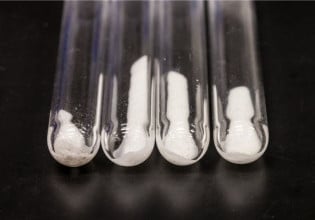Can Aqueous Iron Flow Batteries Aid Renewable Energy Storage?
Pacific Northwest National Laboratory has developed a safe and inexpensive battery for energy storage using Earth-abundant materials.
Electrical power engineers have effectively integrated renewable energy into the power grid, and renewables provide up to 20 percent of U.S. electricity. However, moving to the next level will require large-scale systems to store excess energy when the sun shines and the wind blows and return it to the grid when renewables provide less energy.
Battery energy storage systems (BESS) use electrochemical reactions to store electricity and return it almost instantaneously when needed to bolster the power grid. Lithium-ion batteries, commonly used in electric vehicles, cell phones, and other electronic devices, are one way to provide this storage. However, they are expensive, must be charged and discharged carefully, and have a limited lifetime.
Battery energy storage system in Washington state. Image used courtesy of Wikimedia Commons
As an alternative, Pacific Northwest National Laboratory (PNNL) has developed an iron-based flow battery using a chemical commonly used in water treatment plants. This battery could enable large-scale, inexpensive BESS.
Flow Batteries
The concept of a flow battery dates from 1879. A flow battery has two tanks containing a different liquid electrolyte (catholyte and anolyte). The liquids meet in an oxidation-reduction (redox) reaction chamber. An electrochemical reaction stores energy through chemical bonds when the flow battery is charged. The reverse reaction releases the stored energy when the battery is discharged through an external circuit. The liquid electrolytes are continuously pumped from the tanks into the reaction chamber. The amount of energy that can be stored largely depends on the size of the electrolyte storage tanks.
Vanadium redox flow are the most commonly commercially used batteries but have limited power and energy densities and are expensive. The search is on for more Earth-abundant materials to build safe, economical, water-based flow batteries with adequate capacity for grid storage.
Iron-Based Flow Batteries
PNNL researchers are developing a flow battery using a commonplace iron-based chemical used in water treatment facilities in a new flow battery design.
As reported in Nature Communications, PNNL’s laboratory-scale iron-based battery has exhibited good cycling stability for 1,000 consecutive charging cycles, maintaining 98.7 percent of its maximum capacity. Previous studies of other iron-based flow batteries have shown capacity degradation by a factor of 10 or more during the same number of charging cycles.
Liquid iron flow battery for energy storage. Image used courtesy of PNNL/Sara Levine
What makes the new PNNL battery different is how it stores energy. The liquid chemical combines charged iron with a neutral-pH phosphate-based liquid electrolyte as an energy carrier. The chemical nitrogenous triphosphonate, nitrilotri-methylphosphonic acid (NTMPA), is usually used to inhibit corrosion in water treatment plants and is easily commercially available. This non-toxic phosphonate dissolves well in water and is also used in detergents and fertilizers.
The PNNL iron-based aqueous flow battery can operate at room temperature, and its liquid electrolytes are at a neutral pH. These factors increase the safety of the device.
PNNL researchers report the flow battery design has an energy density of up to 9 watt-hours per liter (Wh/L). This is significantly less than the 25 Wh/L a commercial vanadium-based system will attain. This might appear to be a problem, but the low cost of the materials in the iron-based flow battery means stationary BESS batteries can be made very large (scalable to the size of a city block) and still be economically feasible. PNNL is also working on voltage output and electrolyte concentration to help boost the battery’s energy density to make its battery more attractive.
Flow batteries will be an important next step in using renewable energy for electrical power grid support, and inexpensive water-based systems like the PNNL battery will be an important part of the decarbonization strategy.








